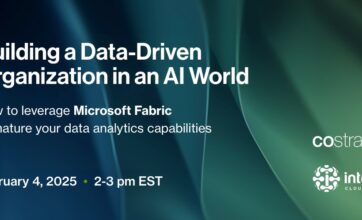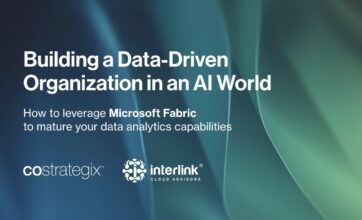How to Align AI Initiatives with Strategic Goals
- 5 minutes read
How do you make sure that your AI/ML project doesn’t land in the heap of failures? The best way is to properly align your AI initiatives with the business’s strategic goals from the get-go. While this seems intuitive, it can be much harder than it would seem.

The failure rate of AI and machine learning projects is notoriously high. Yet despite these dismal numbers, a recent State of AI Report shows that 86 percent of organizations prioritize AI/ML above other IT initiatives. In fact, 42 percent of those organizations named AI/ML as their leading IT priority! Even small increases in predictive ability can spark enormous increases in economic value. The growth in AI/ML initiatives seems unlikely to slow anytime soon given this genuine potential for AI to revolutionize decision-making and disrupt decades-old industries.
Here are some guidelines for aligning your business fit before starting an AI/ML project:
Figure Out How to Measure the Resulting Business Value
There may be rare situations when exploratory AI/ML makes sense – that is, when you go looking for outcomes without having a specific goal in mind. But most of the time, organizations define the desired outcome before engaging in the AI/ML planning process. What many of them don’t do, however, is to quantify how the intended value can be measured.
Data Scientists tend to measure AI/ML outcomes. But measuring an outcome is different from measuring value. If you take a look at the most common use cases for AI/ML (see use cases sidebar), you can see that it may be easy enough to measure how many times a model identifies a pattern, extracts certain information, engages with customers, or improves knowledge. But those outcomes alone probably won’t provide the business value that your users are truly seeking. They are looking for the actual value added when a pattern identified leads to a new product, or when a customer engagement prevents customer churn. That is, they are looking for increased revenue, decreased costs, or reduced risk.
Measuring value can be challenging – sometimes even impossible. But engaging in the discussion will go a long way to ensuring the business fit for your AI/ML initiative.
The key here is to ask good questions. Here are a few questions that may be helpful to measure value and align the AI initiative with strategic goals:
- What is the problem? What objective are we serving? What are we trying to achieve?
- What kind of decisions do you want to support? Why is that important?
- What does success look like?
- Who is the end-user? What will change once the solution is implemented?
- What is the difference between measuring outcomes – and measuring value?
Drill Down into the Complexities When Defining the Goal
Typically, organizations are able to align on big-picture goals. The business users may define a goal such as:
- Discover customer behavioral trends that will predict future purchases
- Automate the order-to-fulfillment process
- Extract a subset of product use cases for immediate customer service interactions
- Predict worker absenteeism to improve scheduling
It’s drilling down into the details of the next level that is more difficult – and more critical. In the predicting worker absenteeism example above, it is important to understand what data is truly available. The amount of data required would be different if you want to predict absenteeism on a national level versus a single location. If the data is not sufficient to predict absenteeism for a single location, you could look for acceptable alternatives, such as: Grouping the data using existing categorical attributes (e.g., geography, gender, age, etc.); Using clustering techniques to derive groups using similarities and differences; or Developing a technology solution like an app to collect more data points.
Again, this process comes down to asking good questions. Sometimes this process can be mind-bogglingly complex. It may require visual tools for mapping resources and their relational connections, or graphing process flows – including the dependencies for sequential and parallel tasks. You might find that you need to engage resources from other departments to answer some of the questions.
Yet these focused details will help your technical team align the scope of work according to your available budget and resources. They will be able to evaluate the tradeoffs between out-of-the-box and custom solutions, rank-order the implementation tasks in terms of ROI, and prioritize tasks that add the most value to the end solution.
Here are a few probing questions that can be helpful during this stage of the process:
- What level of accuracy is required?
- How timely do insights need to be?
- What is available? What data can we create? What data can we buy?
Actively Manage Change
By definition, AI/ML initiatives will change a process. It could be a simple change such as providing a supporting input into an existing decision-making process. Or you could fully automate a routine decision-making process in order to elevate the role of the human decision-makers.
One of the most overlooked reasons that AI/ML initiatives fail is that the organization does not adapt internal processes to account for the change precipitated by the AI/ML initiative. Organizations may fail at realigning work, training staff on how to use the new process, or coordinating work or handoffs between teams. Often, that’s because these types of internal shifts often require authority above a single line-of-business manager.
Equally as common, teams accustomed to traditional ways of working often find the transition to a data-driven mindset unsettling. In order for your AI/ML initiative to be successful, you must build trust that data-driven decisions are, indeed, superior to gut feel or tradition. If business managers or executives cling to old wisdom or refuse to yield their decision-making authority to an analytics process, there will be no transformation or value gained.
Here are a few questions that you can ask to facilitate the change-management process:
- What teams will be impacted, and how?
- What kinds of decisions could be impacted by this data?
- What KPIs will be affected?
- What change-management processes will be included in the solution?
- What should executive sponsorship look like?
- What will we communicate to our employees and stakeholders? How will we build awareness?
Plan for the Long Term
Some organizations look at an AI/ML initiative as one-and-done. A better analogy would be an investment in a car, which needs to be maintained, oiled, and polished. AI/ML models need to be maintained, retrained, measured for quality concerns like drift or class imbalance, and tested for accuracy, precision and confidence. Data isn’t static over time, so models may need to be tweaked or updated.
In addition, the more precise the model becomes, the more value you can gain over time. It’s like fine wine – the more you invest in learning and experimentation, the deeper the flavor. The insights that you may develop from your AI/ML initiatives can well become your unique competitive advantage – like a Google or Netflix algorithm.
Finally, even if AI/ML initiatives aren’t applicable to you today, it would behoove you to consider what data you may want in the future. For instance, if the volume of data you need to make useful decisions is not available today, start thinking about how you could start gathering such data. Some data cannot be collected retroactively.
Ask the Right Questions Up-Front, and Listen to the Answers!
In short, the better your questions are upfront in the planning stage, the better you will be able to align your AI/ML initiatives with your strategic goals. And while each business problem requires its own unique process breakdown, having a standardized approach to aligning AI initiatives to strategic goals drives cohesion and reproducibility across your teams and organizations.
CoStrategix is a digital and data solutions firm with extensive experience in developing both custom insights and analytics and custom AI/ML solutions. We help organizations apply best practices and shorten the learning curve to gain value from their data projects.
AI Strategy & Solutions – Elevate your business with advanced analytics
Data & Insights – Drive insights that lead to competitive advantage
Product Development – Build platforms that power unique digital capabilities
Platform & Technology Modernization – Modernize for stellar experiences, efficiency, and AI
Related Blog Posts
4 Pitfalls to Avoid When Creating a Customer Journey Map
July 12, 2022
Building a Data-Driven Organization for an AI World 2
February 5, 2025
Building a Data-Driven Organization for an AI World
January 28, 2025
AI POC Best Practices
January 13, 2025







